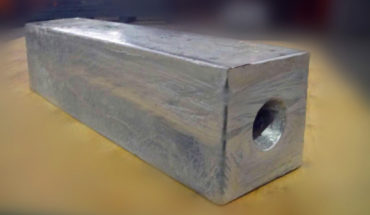As the name suggests, sacrificial anodes are metal pieces that are electrically linked to the hull of the ship and other sub-sea systems and equipment. They are made of more reactive metals than the ones used in making the ship’s system and body. Due to their higher reactivity, they are the first to suffer corrosion instead of the ship, thus protecting the vessel from corrosion. One of the advantages of sacrificial anode system is that it helps the protected system stay safe from corrosion damage, hence improving its lifetime. Have you ever heard phrases like ‘I would take a bullet for her or you?’ or I would die for something? The expressions mean that the person speaking can take a risk in place of the other person or something they care about. This is called a sacrifice. It’s the same case with the sacrificial anode system. For a ship, one typical example is the sacrificial anode which is a kind of cathodic protection system.
An anode is an alloy made from a highly reactive metal- (whose electrochemical potential is more negative) than the system it is protecting which is the cathode. The potential difference between these two metals means that the anode- Sacrificial metal corrodes in place of the cathode- The structure being protected. Therefore, the structure is protected from corrosion as the anode system prevents any oxidation reaction happening on the structure which is being protected. There are many advantages of sacrificial anode system, but there must be two conditions to protect the system from oxidation effectively. These conditions are that there should be a path for the return current to allow electrons flow between the anode and the protected metal- the path is created by physical contact or an electrolyte which can be water or humidity to transfer electrons.

Suitable metals for sacrificial anode systems
The metals high in the reactive series such as aluminum, magnesium, and zinc are used to create sacrificial anode systems. Metals with high negative electrochemical potential such as magnesium are used where electrolyte resistivity is most high. A good example is the pipelines on the on-shore. Where resistivity is lower- such as salty water, metals like aluminum and zinc are used. Typically, they are used for boats’ and ships’ hulls, rudders, storage tank’s internal surface, and other structures operating in sub-sea. The advantages of sacrificial anode system in every sub-sea structure include:
- They require no external power to work effectively.
- It’s easy to install the system, and no maintenance is required.
- It’s rare for a sacrificial anode system to produce a stray current because of very low current and the voltage between the protected surface and the anode.
- It’s easy to inspect and monitor the system for the trained personnel.
- Sacrificial anode system is very reliable and protects for over 25 years
- Sacrificial anode system poses no penetrations or modifications on the hull’s interior.
- The cost of the overall life cycle is generally low.
- Poses no interference risk.




